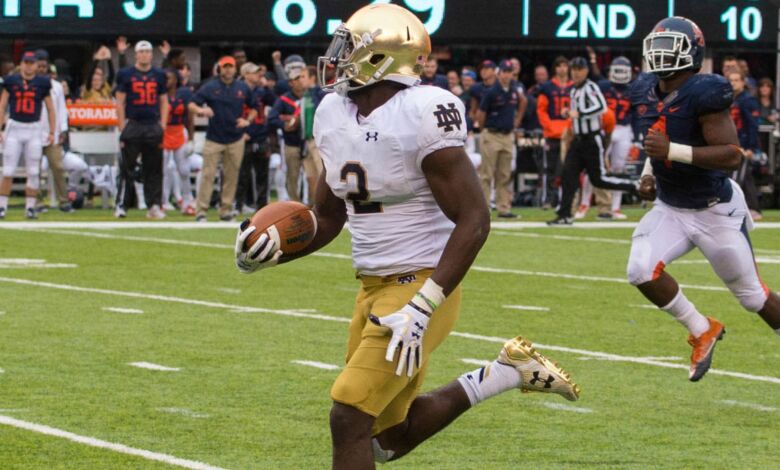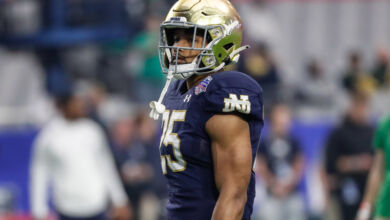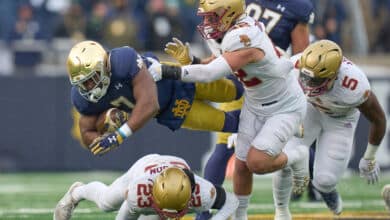
If you are a connoisseur of Notre Dame information and practice updates like me, you have noticed the excitement level around the their three top running backs–Josh Adams, Dexter Williams, and Tony Jones Jr.–is at a very high level. Adams looks healthy and strong, Williams is sleek and explosive, Jones is bursting onto the scene.
Because this is Notre Dame and there can be no good things, this has also become a source of concern. How is Notre Dame going to maximize the talent at the position when they have been so poor at doing so in the past?
It’s a valid question. Dexter Williams was essentially wasted last year as the third team back, only carrying the ball 39 times over 12 games, a meaningless three carries a game while averaging five yards a carry. Tarean Folston tallied double digit carries just three times. Never did two backs have it going at the same time. When Adams was rolling, Folston and Williams sat. When Folston was playing well, Adams sat. Any semblance of a two headed monster or a running back by committee system was largely non-existent.
The problem here is two fold. First, what’s the point of having a talented and deep offensive backfield if you’re not going to use them to compliment each other and not use the depth to your advantage? And second, in pretty much every game, two talented players are just standing on the sideline, not contributing anything meaningful to the game. It’s a waste of talent.
Can new offensive coordinator Chip Long provide a remedy to this problem and take advantage of a roster with what looks like three (and as many as four) talented backs? What would that even look like? Evidence from his past could provide the answer.
2012 Arizona State Provides The Template
In 2012, Chip Long worked under offensive coordinator Mike Norvell, who later promoted Long to offensive coordinator and play caller, as the tight ends coach. That year, Arizona State had three very talented backs who were ready to play and contribute heavily on the field: senior Cameron Marshall, junior Marion Grice, and freshman D.J. Foster. Marshall entered the season with over 2,000 yards rushing for his career and a 1,000 yard season the year prior, Grice was in his first season after transferring from junior college rushing for 2,200 yards and 33 touchdowns, and Foster arrived as a four star recruit and the #5 athlete in the nation.
The situation is similar to Notre Dame’s in 2017: all three of those guys needed to play and simply competing for carries in practice and the best man wins the lions share would have been a disservice to the team. Why deprive two other talented ball carriers who can produce when given the chance? Norvell’s apparent solution was to divide up the touches evenly and he did so very effectively.
| Touch/Game | Tot Yds | Tds/Game | Total TD | |
|---|---|---|---|---|
| Marion Grice | 11.1 | 1,104 | 85 | 19 |
| Cameron Marshall | 11.3 | 678 | 52.2 | 10 |
| DJ Foster | 10.8 | 1,026 | 79 | 6 |
All three backs averaged 11 touches a game and all three totaled over 100 carries on the season. The group totaled 35 touchdowns rushing and receiving over the course of the season, a pretty stunning number from one position group. By contrast, the most total touchdowns from the running back position under Brian Kelly came in 2015, when CJ Prosise, Adams, and Williams tallied 20.
They were also able to be productive in the same game, unlike what we’ve seen from Notre Dame. In 31% of the games in 2012, all three backs garnered 9 or more touches in a game, with six games where the three backs totaled 30 or more touches, including a game against UCLA where they racked up 58 touches for 374 yards and five touchdowns. They spurred on ASU’s 25th nationally ranking in both total offense (464 yds/game) and rushing offense (205 yds/game).
An interesting wrinkle to the 2012 Arizona State situation? Quarterback Taylor Kelly also tallied over 100 carries on the season (133), for 520 yards and another touchdown. He was also able to throw for over 3,000 yards and 29 touchdowns. Those numbers would look pretty darn good on Brandon Wimbush this year.
The Key Is In The Receptions
The biggest difference in the way the Long/Norvell offense utilizes their running backs and the way the Kelly/Denbrock offense uses their running backs is their involvement in the passing game. In 2012, DJ Foster and Marion Grice combined for 79 receptions, for 958 yards, and 12 touchdowns. In 2013, those numbers grew to 93 receptions for 1,091 yards and 10 touchdowns. If you add up the reception numbers for every running back at Notre Dame over the last three seasons you’d get 94 receptions, 941 yards, and 4 touchdowns. Looking at the numbers over the same time period at ASU and Memphis, the contrast is staggering.
| Rec | YDs | TDs | |
|---|---|---|---|
| Notre Dame | 94 | 941 | 4 |
| ASU/Memphis | 195 | 1,900 | 16 |
Norvell and then Long are simply better at utilizing their backs and getting them the ball in ways beyond simple handoffs. Are they able to get three backs involved in the offense as consistently as they did the group at Arizona State in 2012? No, of course not, it’s a pretty rare situation where you have three backs who are capable of handling a consistent workload plus the skill set to be useful in a myriad of offensive situations. But, it’s pretty apparent that the Norvell offense is more than capable of handling such a situation very well.
The 2017 Running Backs
The biggest part of finding time for three backs is having the motivation to get three running backs involved on a game to game basis. Teams don’t go looking to distribute carries to a trio of players; it’s a tough thing to do.
If you’re inclined to believe the reports from practice, Chip Long’s ability and background to get three backs involved is fantastic news to Tony Jones Jr. Not only is he looking like the third back, according to reports, but he’s also looking like a guy who needs to be a factor on the 2017 Notre Dame football team.
In fact, he has so far shown to be the best and most natural receiver of the top three players at the position, which could be the x factor to solidifying his spot on the field. As I outlined above, catching the ball is extremely important in this offense and brings a dimension the other guys might lag on.
This is also fantastic news for true freshman CJ Holmes, who would fit the DJ Foster mold better than anyone currently on the roster at running back (Deon McIntosh would also be VERY interesting in this role, but so far there are no signs of it). He showed himself to be a natural receiver in high school, even playing out wide at times. He put on a show last year at the Notre Dame junior day catching passes and wowing his future teammates with his ball skills. Kelly has said they want to put in a package for Holmes this season, but there isn’t a “This is how Arizona State integrated four backs” article to be written, so we’ll see.
Josh Adams and Dexter Williams are the mainstays. Adams has got 174 carries to his name, so he’ll be featured prominently. Fans have been pining for Williams, and his Julius Jones running style, for two years now and you have to figure the coaches are ready to turn him loose. It’s hard to see three guys getting around 140 touches on the season, as with the 2012 Arizona State group, simply because injuries happen and that kind of rotation hasn’t been the case at Notre Dame in a long time. I do expect all three to factor prominently week to week and the creativity and the flexibility within the offense is there. So when we see reports of the running backs starring, consternation about “how are they going to distribute the carries, I’m so stressed!” should not be what follows.




Excellent article, Greg. This statement hits the nail on the head regarding the running game last year – “Any semblance of a two headed monster or a running back by committee system was largely non-existent.”
I’d like to see us finally run the ball 50 times when we play smaller opponents like Navy/Army etc….There is no reason we shouldn’t be running on these teams all day. Our O-Line and D-Lines outweigh theirs at 60 lbs per position
I know all 3 bring small differences to the table in terms of one thing that might stand out over another back. However, if they are truly interchangeable to where each of them can at least do everything necessary as a back, then I say filter in at least 2 of the 3 very consistently to keep fresh legs and don’t make it obvious in the playcalling that you are running a play that will play to a certain back’s strengths. Over the course of the year, it will save their bodies a little more than featuring one back for an entire series, quarter, etc., as an example. Then you have to look to see who is running hard too. If one of them isn’t hitting the hole the way they should, then bench them until they are ready to run hard. When Adams gets north and south at full speed and gets behind his pads, it is difficult to take him down with one man. No more dancing around, lets get up field.
First off, good article. I think despite not having the unfettered access of other beat writers, this site manages to provide- strangely- somewhat more informative/thought provoking material.
I agree with the Julius Jones comparison. In fact, at the beginning of the article I was trying to recall the last back who resembled Dexter and immediately thought Julius Jones. What do you know, three paragraphs later, the same company was made.
go irish
Sorry, but, I can’t remember His name (shows what age does to you) but, no big changes at running back till the arrival of the back from Indiana or is it Ohio, whatever, He will turn it around like Vagas Ferguson, Ricky Watters, Erik Penik. He reminds me of Emmitt Smith. Best of all is He is a Team player.
Thanks for this insightful article. I say we use whatever formations we can to create as many mis-matches as possible. GO IRISH!
Greg,
I would still like to see us get into a two back “O” once in awhile. This does not mean that I want to scrap Coach Kelly’s offense – nothing could be farther from the truth. I like his “O”! But sometimes I think that on third and 1 (or 4th and 1) Wimbush ought to line up under center with two backs and a third tackle or a third tight end and see what the other team is made of. According to your article, we’ve got the backs to do it.
Bruce G. Curme ’77 ’82